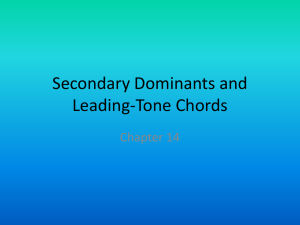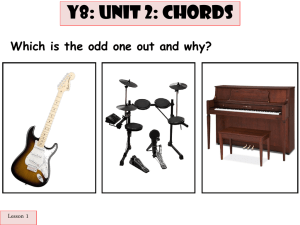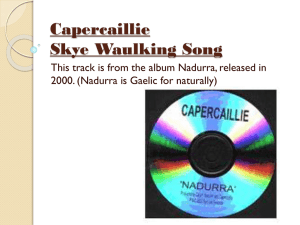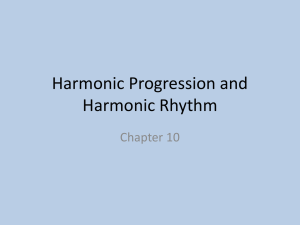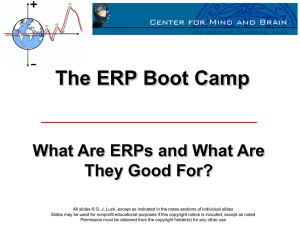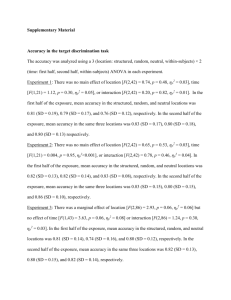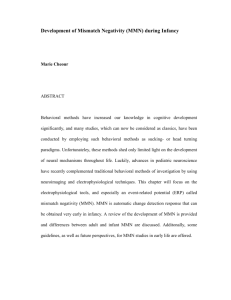Effects of age group and personality on cognitive and affective
advertisement
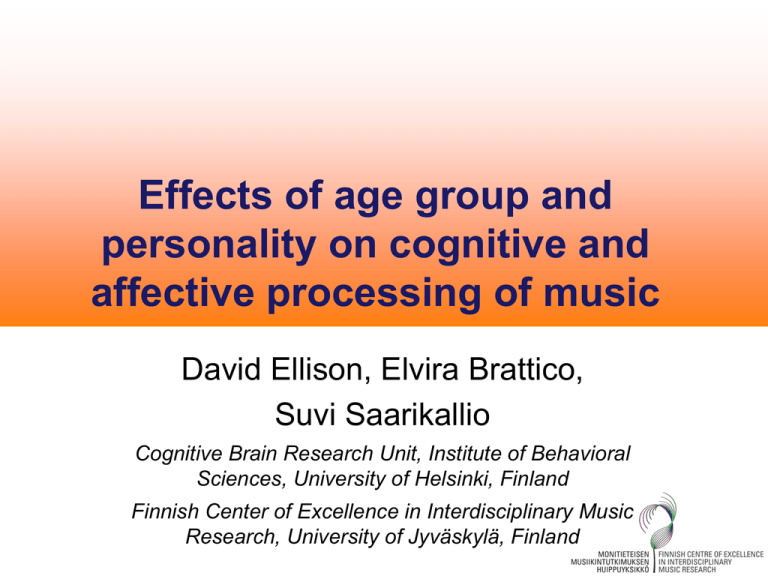
Effects of age group and personality on cognitive and affective processing of music David Ellison, Elvira Brattico, Suvi Saarikallio Cognitive Brain Research Unit, Institute of Behavioral Sciences, University of Helsinki, Finland Finnish Center of Excellence in Interdisciplinary Music Research, University of Jyväskylä, Finland Background • Event-related potential (ERP) • • • • Observed brain response to an event (e.g., auditory stimulus onset) Recorded using electroencephalography (EEG), which measures electrical potential (voltage) between points on the scalp and a reference Averaged over many trials and across participants Can be negative or positive (in potential energy) • Behavioural data – frequencies of certain responses, reaction time (RT) • Personality test – “Big” Five Factor Model ERPs to music in adults (early, automatic) • N100 or N1 • Fronto-central, 80-120ms • Onset of unpredictable stimulus • Followed by P2 • Mismatch negativity (MMN) • 150-250ms fronto-central • Deviant auditory stimuli • • Physical feature deviance (e.g., freq., intensity) (phMMN) Abstract (musical) feature deviance (afMMN) • • Descending vs. ascending intervals (Saarinen et al., 1992) Major vs. minor chords (Virtala et al., 2011) • Early right anterior negativity (ERAN) • Unexpected chords; music expectancy violations • 150-180ms, anterior and often right-lateralized ERPs to music in adults (later, attentive) • P300 • Peaks parietally 300ms after incongruous note/chord at end of melody/cadence • Improbability of task-related stimuli • P600 • Syntactic language and music ERP • Re-analysis of musical and linguistic sequences following incongruity ERPs to music in adults (affect, emotion) • Late positive potential (LPP) • Indexes emotional arousal of stimuli, usu. Pictures • starts ∼300–400 ms after picture onset and sustains throughout picture presentation • Brattico et al. (2010) – cadence ending chords • • 600ms positivity to negatively-rated cadence resolutions in both correctness and liking tasks 1000-1800ms slow parietal positivity associated with ’dislike’ ratings ERPs to music pre-adulthood • Enhanced MMN in chord discrimination task in musically-trained 13-year-olds (Virtala et al., 2012) • Clear ERAN by age 5, albeit longer latency than adults (230–240 ms; Koelsch, Grossmann, et al., 2003; Jentschke et al., 2008) • Is this due to neuro-anatomical development, or establishment of music-syntactic representations? • Indistinguishable from adult ERAN by age 11 (Jentschke et al., 2005) Individual differences in music processing • ERP difference factors • • • • • • Age Gender Musical training (ERAN, MMN) Infant temperament (P3a) Emotion regulation deficits (anx., depression) modulate LPP Personality • • Music genre preferences Music-listening habits (Chamorro-Premuzic & Furnham, 2007) • • • Perception of musically expressed emotions (Vuoskoski & Eerola, 2009) • • • Openness to experience – intellectual music appreciation Neuroticism, introversion, less conscientiousness – music as mood regulation Neuroticism - sad & tense ratings Extraversion - positive ratings No study of effects on music ERPs Objectives How does the brain respond to affective vs. cognitive processing of music in adults and adolescents? Do these groups differ? What is the role of personality? Does it influence individual affective/cognitive brain responses to music? Experiment • 58 participants • 34 fourteen-year-olds (10 male) • 24 adults (9 male) • Questionnaires: Ten Item Personality Inventory (“Big” Five Factor Model), Music Appreciation Scale, Rosenberg Self-Esteem Scale • EEG listening experiment with rating task Stimuli Task design • Each trial consisted of 5-chord cadence + one of two tasks: • Cognitive – does the ending sound correct or incorrect? • Affective – does the ending sound happy or sad? • Task cue 1st 4 chords final chord maj/min intune/mistuned behavioural response • ERPs from cadence onset • Preparation for cognitive or affective task • Averaged by task type • ERPs from final chord onset • Response to target chord • Averaged by behavioural response type (BR) and by stimulus category Behavioural results • Cognitive task RT < affective task RT • F =4.130, p=.047, ηp2=.069 • Adolescent RT < adult RT • F=4.284, p=.043, ηp2=.071 • Participant ratings more likely to conform to researcher expectations than to disagree • • F=176.641, p=.000, ηp2=.759 i.e., major resolutions rated as ‘happy’, chords containing mistuned notes rated as ‘incorrect’ No effect of group on this • • Adults on avg rated 93±3 items as correct, and 61±3 as incorrect • F=6.065, p=.017, ηp2=.098 • Correlation between “correct” and “happy” ratings • r=.425, p=.001 Task-averaged ERP curves and scalp maps • • Larger negative peaks = N1s during affective task than cognitive task after the 1st and 2nd chords These were larger in adolescents than adults BR-averaged ERP curves and scalp maps Behavioural response ERP averaging • At around 300ms • • • Adults: significant MMN/ERAN to negatively-rated stimuli (“sad” or “incorrect”) for both tasks Adolescents: MMN/ERAN to cadence resolutions rated “sad” only from left and midline of scalp; MMN/ERAN to cadence resolutions rated “incorrect” only from right At around 500ms • • Larger P300 in adults than adolescents At around 700ms • Adolescents: negative ratings (“sad” or “incorrect”) elicited larger LPPs than did positive ratings, but for adults, this difference was not quite significant on the right side of the scalp. Stimulus-category-averaged ERP curves and scalp maps • • • At 300ms, larger negativity to mistuned ending chords relative to correctly-tuned ending chords (MMN) and also to minor resolutions relative to major resolutions (ERAN) At 500ms, larger central P300 for mistuned than tuned chords At 700ms, larger centro-parietal LPPs to minor chords and mistunings Stimulus-category-averaged ERP curves and scalp maps • Adolescents elicited larger ERAN than adults to major resolutions but did not differ significantly from adults following minor resolutions. Correlations with individual difference scales – results and discussion • Higher extraversion associated with slower reaction times when rating a stimulus as sounding sad (p=.005) • Extraverts’ bias toward positive emotional ratings of music (Vuoskoski & Eerola, 2009) and proneness to feel positive emotions • Higher music appreciation score associated with higher accuracy on the affective task (p=.008) • Only in adolescents: conscientiousness associated with smaller ERAN responses to sad-rated stimuli (p=.001) • • Even though conscientiousness has in the past been associated with larger P300 in auditory mismatch task (Gurrera et al., 2001; 2005) Only in adults: openness to experience associated with larger late posterior negativities (LPN) to sad stimuli peaking at around 1250ms (p=.003) • • ERP component related to long-term memory Perhaps those more open to experience are more likely to commit certain types of chord progressions to memory. ERP Discussion • Enhanced negative responses to cadence chords during cognitive task similar to findings of Brattico et al., 2010 • • • • But also enhanced negative responses in adolescents Perhaps related to establishing tonal context • • • • • Enhanced negativity at 300ms Late negative difference (late Nd), working memory (Singhal & Fowler, 2005) More demanding or important in cognitive task? Still developing in adolescence? Early negativity (MMN/ERAN) to mistuned and minor chords, and to those rated as sad or incorrect More ERAN-like response in adolescents (w.r.t. adults) to major chord endings Do these harmony/affect-related ERANs indicate unexpected chords? Future questions Longitudinal data has been collected from same adolescent participants at age 16. Will their data differ? How do they prepare for cog/aff tasks? Will the correlations between personality and ERP amplitude hold up with a more robust measure of personality? What do they mean? What is early negative component differentiating major from minor and sad from happy? Is it really ERAN? Works cited Chamorro‐Premuzic, T., & Furnham, A. (2007). Personality and music: Can traits explain how people use music in everyday life?. British Journal of Psychology, 98(2), 175-185. Gurrera, R. J., O’Donnell, B. F., Nestor, P. G., Gainski, J., & McCarley, R. W. (2001). The P3 auditory event-related brain potential indexes major personality traits. Biological Psychiatry, 49(11), 922-929. Gurrera, R. J., Salisbury, D. F., O'Donnell, B. F., Nestor, P. G., & McCarley, R. W. (2005). Auditory P3 indexes personality traits and cognitive function in healthy men and women. Psychiatry research, 133(2), 215-228. Jentschke, S., Koelsch, S., & Friederici, A. D. (2005). Investigating the relationship of music and language in children: Influences of musical training and language impairment. Annals of the New York Academy of Science, 1060, 231–242. Jentschke, S., Koelsch, S., Sallat, S., & Friederici, A. D. (2008). Children with specific language impairment also show impairment of musicsyntactic processing. Journal of Cognitive Neuroscience, 20(11), 1940-1951. Koelsch, S., Grossmann, T., Gunter, T. C., Hahne, A., Schro¨ ger, E., & Friederici, A. D. (2003). Children processing music: Electric brain responses reveal musical competence and gender differences. Journal of Cognitive Neuroscience, 15, 683–693. Saarinen, J., Paavilainen, P., Schöger, E., Tervaniemi, M., & Näätänen, R. (1992). Representation of abstract attributes of auditory stimuli in the human brain. NeuroReport, 3, 1149–1151. Virtala, P., Berg, V., Kivioja, M., Purhonen, J., Salmenkivi, M., Paavilainen, P., & Tervaniemi, M. (2011). The preattentive processing of major vs. minor chords in the human brain: An event-related potential study. Neuroscience letters,487(3), 406-410. Virtala, P., Huotilainen, M., Putkinen, V., Makkonen, T., & Tervaniemi, M. (2012). Musical training facilitates the neural discrimination of major versus minor chords in 13‐year‐old children. Psychophysiology, 49(8), 1125-1132. Vuoskoski, J. K., & Eerola, T. (2009). Personality traits moderate the perception of music-mediated emotions. In Frontiers in Human Neuroscience. Conference Abstract: Tuning the Brain for Music.

